Blast From the Past: Atlantis (Revell) F11F-1
This is a "new" kit from Atlantis, which is actually the 1956 Revell 1/54 model of the "short-nose" F11F-1 Tiger used by the Blue Angels in the 1950s. Atlantis has been re-releasing old Revell kits for a while, at first with the slot and swivel for the fuselage, and the globe base. More recently they have deleted the slot for the swivel, but you can still get the globe base and swivel separately if you want to put your model on the pedestal. Some of their kits have been issued with the raised lines that indicate where the decals should go (remember them?), and some of the kits have had these lines removed. This kit originally had the decal locations shown by indented lines in the plastic. Atlantis eliminated these indentations in this kit, but they apparently missed a few. The locations for the intake warning stripes and the ejection triangles are present, and required filling.
Aside from that, the kit went together like you would expect. I built the kit in sub-sections that were assembled and painted before assembly. This was thanks to the fact the wings and elevators slotted into the fuselage perfectly and required no putty at all.
The only drama in this kit was self-induced. I decided I wanted to finish the model using only spray cans. Yes, I am lazy, and I only get out my airbrush when I have to. The Tamiya Navy Blue went on perfectly, even though it is a little dark for the color the Blue Angels used in the 1950s. I sprayed the yellow tips and the silver leading edges on the wings, elevators, and rudder using Vallejo spray acrylics. I had some Vallejo spray clear gloss that I used to prepare the surface for the kit decals. I let the clear dry for 24 hours, but then discovered that I couldn't touch the surface without leaving fingerprints that couldn't be wiped off. I polished the surface with car wax, which removed the fingerprints and used latex gloves to handle the model after.
The kit decals were interesting. It looks like they were printed in white first, followed by the yellow. This gives the decals some color density over the dark blue. Unfortunately, the white underlayer was smaller than the yellow layer, which allowed the blue to show through the edges of all the decals. The other problem with the decals was that they tended to stay where they first landed, and resist any effort to move. I used a trick that I learned from my friend Spiros (@fiveten), and applied some Future over the area to be decaled, and then the decal would move freely in the wet Future. Once that problem was solved, the only issue I had was the long decal that goes from around the canopy to the spine of the plane. I managed to massage the tentacles around the canopy without breaking them, but it was a lot less fun than you might think. The kit includes decals to make planes from the 1957 and 1958 seasons, but the instructions are a little sparse on where things should go. I took my best guess. If you happen to be a Blue Angel aficionado and know that I have messed up the markings, then I will apologize in advance. :o)
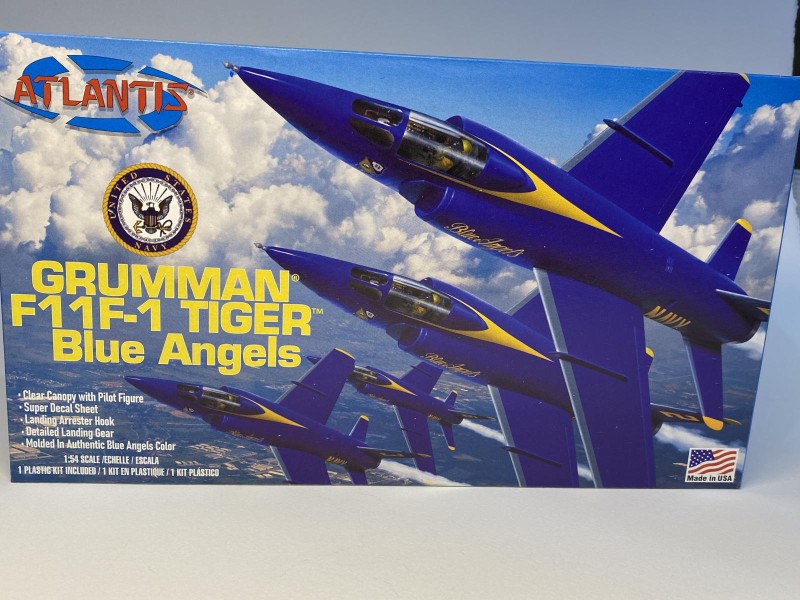
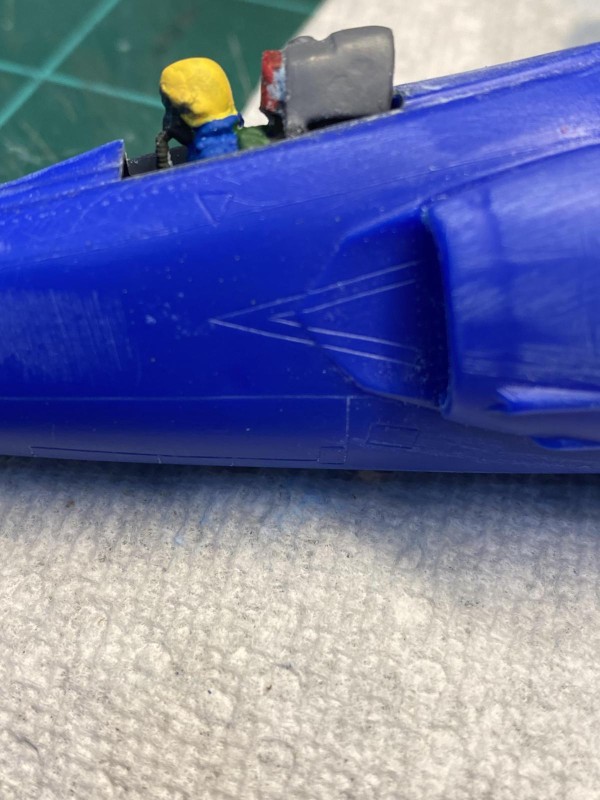
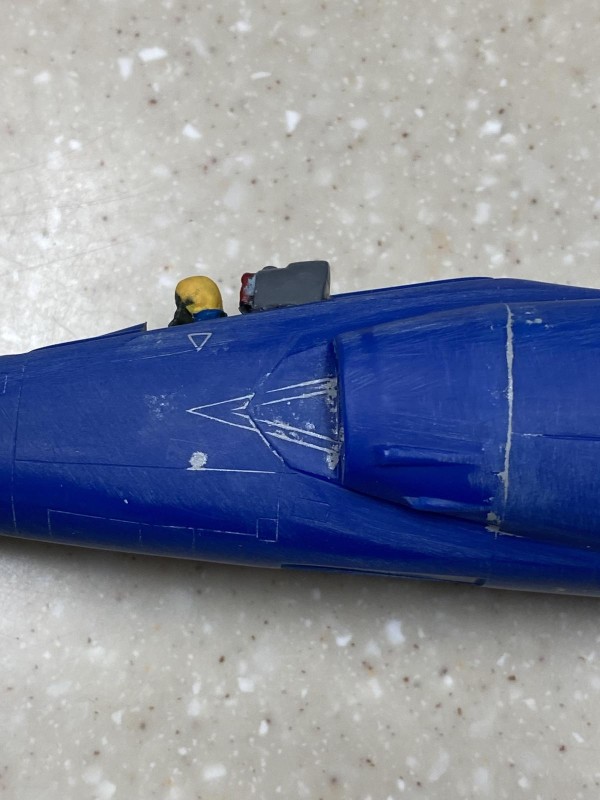
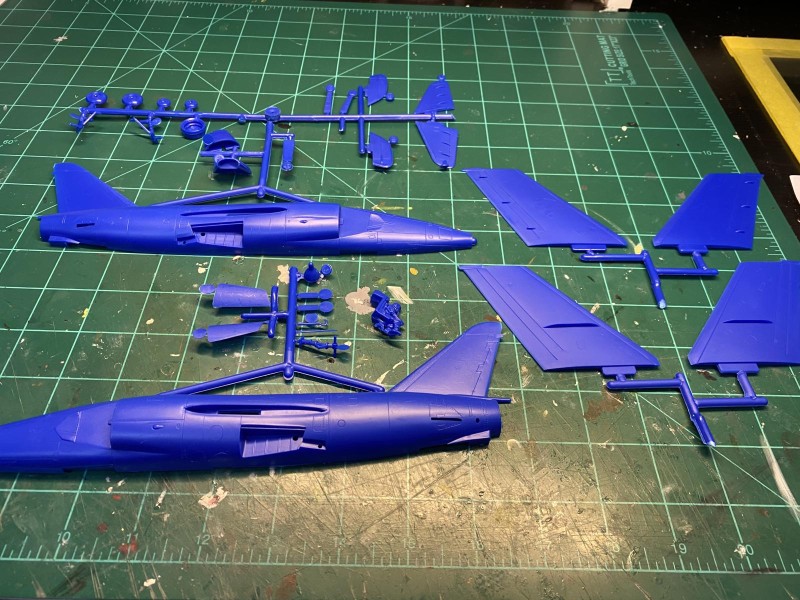
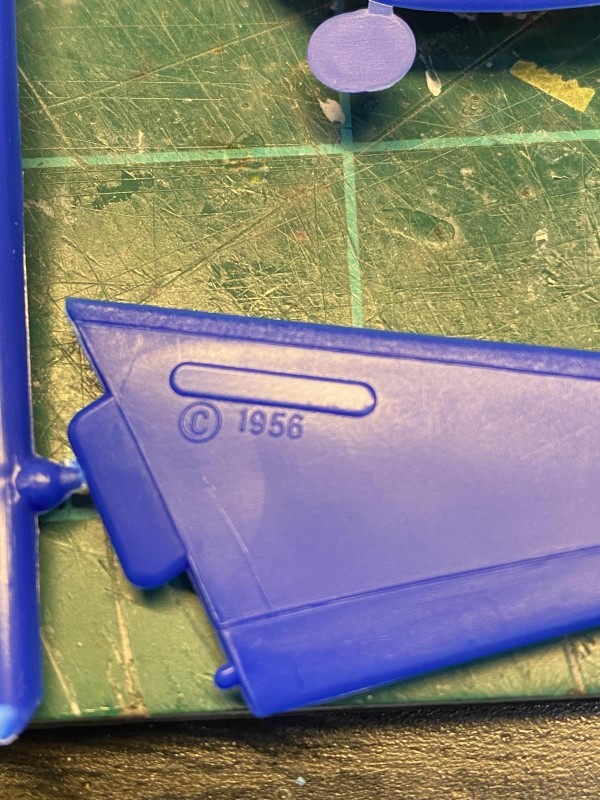
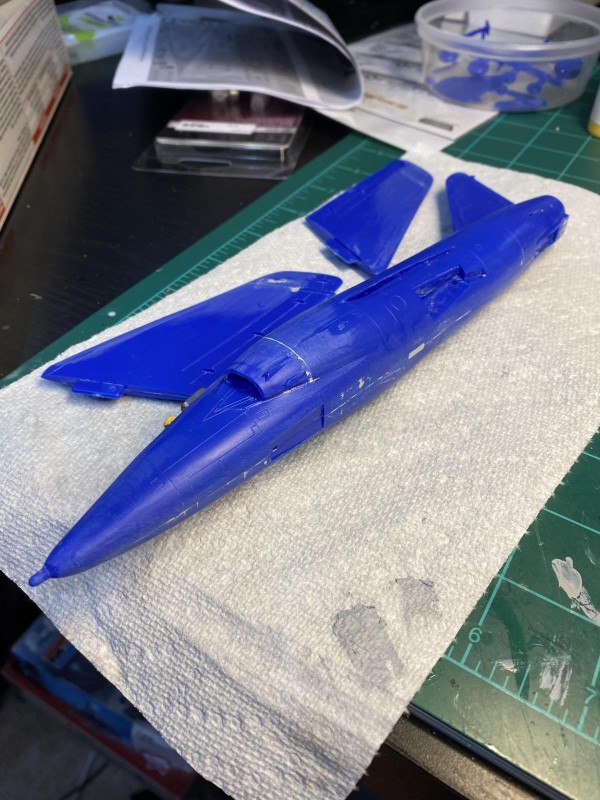
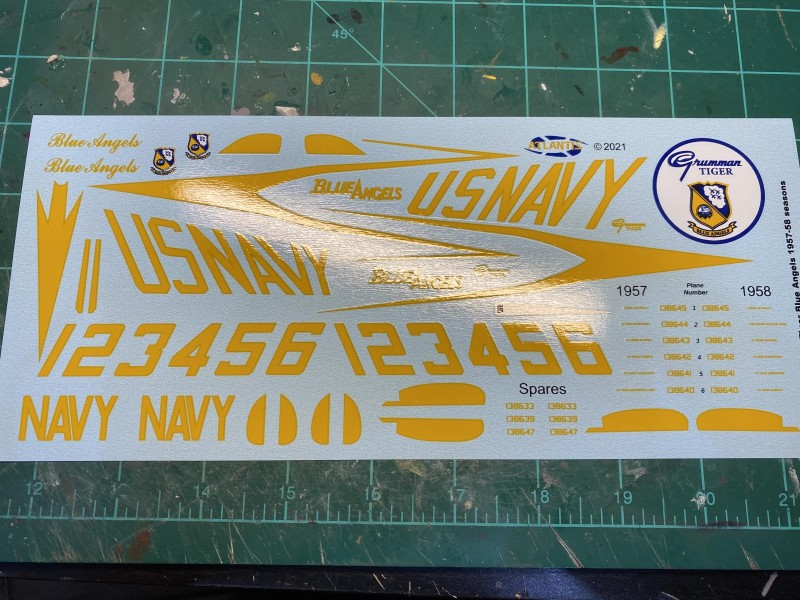
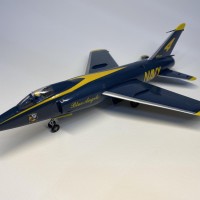
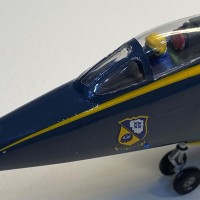
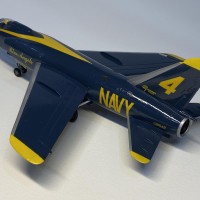
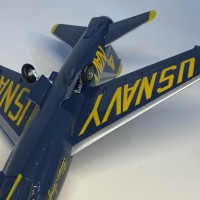
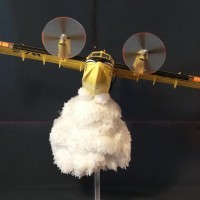
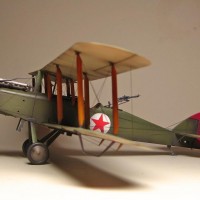
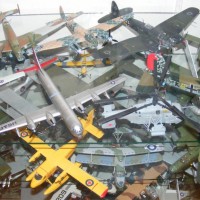

definitely a blast from the past, and you did justice with what you had to work with! Great project.
Probably as close to a 1/48 F11F that won't drive you crazy to build (looking at you, Fonderies Miniatures).
Not a complaint, or a criticism, but Tamiya X-4 blue would have been closer.
Hey Tom,
Try the CollectAire Tiger- I had to chop the fuselage up to straighten it- still not finished, but getting there soon to work on getting it done. I think the pour was taken out of the mold before it was 100% hardened. I have the FM kit as well (2), and the Lindberg!
Hopefully whoever takes on the Kittyhawk Furies will try for an F11F too!?
Thanks, Greg (@gkittinger) and Tom (@tcinla). I found quite a discussion online about the various paint colors used on the Blue Angels over the years, so I knew that Navy Blue was probably too dark. My plan was to only use paint that I had, so my pallet was somewhat limited. I really prefer to model planes that have lost that showroom shine. :o)
George great job, it looks great! I love seeing the older kits made and not kept in a box forever unassembled. Your approach using the more modern build technique made this kit shine.
Amazing Blue Angel bird, George @gblair
It is a beautiful F11.
You did a great job on this oldie.
First time that I see blue clolored sprues, might be helpful for youngsters to easily construct one without painting.
Thanks, Bob (@v1pro) and John (@johnb). I am glad that there are still companies that are re-releasing some of the older kits. They take more work, but can still be made to look pretty good. Plus it reminds me of the first time I built many of these kits back in the good old days. John (@johnb), I remember the first time I built the Red Baron's Triplane, I think the 1/28 version from Revell, it was molded in all red plastic.
Nice to see this built up, came out great! Before Rustoleum canceled Testors paints they. use to to have Blue Angel blue in a rattle can.
Nice oldie, George. That’s one I never had as a kid. If you ever get to Pensacola, check out the Tiger on display. It’s amazing how small it is.
Thanks, Robert (@roofrat) and John (@j-healy). There are still a couple of brands that carry a "Blue Angel Blue", but I wanted to build this one with just what I had on hand. From the little research I did for this kit, I discovered that the blue used by the Blue Angels has changed over the years. As I recall, there was a lighter blue at first, and a darker blue more recently. One of the things I like about modeling is it gives you the chance to compare the relative sizes of planes. I once put an F-4 next to a B-25 in my display case and was astonished to find they were of similar sizes. Boy, it really is true you can make just about anything fly if you put a big enough engine on it.
Nice work on that kit George! There is an article online relating to mixes for Blue Angels Blue, the best one is on tailspin topics and it explains how the first mixes were insignia blue and white, then it moved to a DeSoto Blue (automotive paint) then they had a formula devised up until the 1990's when it was changed to the present colour.
Awesome that this kit offered the angular titles designed by one of the pilots at the time- he later became RADM Rassmussen. He is an artist, and painted quite a few paintings of Blue Angels aircraft as well. I missed the chance to speak to him on one of my trips to Pensacola. I was going to walk up to him and introduce myself but chickened out, because I figured I would have come across as a weirdo fan-boy and gush about NAVAir, and how cool it was to recognize him around the museum and compliment him on being a Blue Angel. I'm not even American...
Thanks, Dan (@danfrombermuda). I did a little research into the color of the Blue Angels aircraft, and discovered that it had changed over the years. My goal was to use paint that I already had, so I used Tamiya Navy Blue from the spray can. At my core, I am pretty lazy and didn't want to crank up the airbrush for paint that I mixed. I don't normally do "showroom" paint schemes, but if I ever do another Blue Angels plane I will mix the color, or try some of the paint lines that claim to have a "Blue Angel Blue". When I was in the Air Force, I got a chance to meet some historic pilots. I was flying through Hickam AFB (Hawaii) and had just finished dinner at the officer's club and bumped into Chuck Yeager coming in as I was going out. I didn't want to bother someone who probably gets accosted by fans all the time, so I just walked up, said "Good evening, Sir" and left him alone. I also went to a small luncheon where Ira Eaker was the speaker. He was very interesting to listen to. By the way, I assume you are from Bermuda from your screen name. When I was flying C-141s, I passed through NAS Bermuda several times, but never got to stay. Very cool place.
What a superb result out of that classic kit, George!
It is just great to see old kits re-released!
Old kits an be fun, especially if they bring back good memories. Nice job George, even with the minor complications it turn out quite well. And as John Healy stated, once you see an actual F11F you'll be surprised how small it is.
Thanks, Spiros (@fiveten) and Tom (@tom-bebout). I always approach these old kits the same way I approach limited run kits and figure on lots of test fit, sanding, and putty. When it comes to the size of the F11F, you have to remember I flew a jet that a Navy pilot friend observed that it was the only jet you could urinate into the cockpit while standing on the tarmac. Those weren't his exact words, but you get the idea. Yes, it is true, the T-37 was small for a jet. It was also slow. I was once flying a navigation mission with a student, and we were over Dallas. The controller came up on the radio and wanted us to confirm we were a jet. I was a little indignant, but told him we were. He asked if we minded being vectored off the airway because a Cessna Twin prop was overtaking us. You really know you are slow when props fly faster than you do. But it was a fun plane to teach people how to fly.
Very nice work George.I love the Blue Angels and this particular aircraft
The older kits are pioneers of sorts and I often wonder about the kit designers that realised them . They are the unsung heroes of our hobby.
There is a Tiger on display in Ridgecrest California at the China Lake air base.
Indeed a small plane and another excellent Grumman design.
Thanks, Bernard (@bernardbedeur). I agree with your thoughts about the early kit designers. I suspect that they not only had to design the kits, but also figure out how to work within the early casting technology. It is a testament to them that these kits still build into nice models. I still have a couple of the old 1/72 Hasegawa Tigers, as well as a couple of the newer 1/48 kits that I still plan to build sometime. I was stationed in California when I was in the Air Force, but never got to China Lake.
🙂 ... Greetings ... 🙂 :
This one for sure makes for a good blast from the past George !
The F-11 is rarely seen, and yet here she is.
Love the lines and design.
The model is sure to look very keen under the Blue Angels scheme.
Thanks, @de4ever. It is cool that some manufacturers keep releasing the old kits again.
I've been collecting kits for my Grumman 'Cats' in the 1/48 range and the F-11 Tiger is the only one I don't have. I didn't want to spend a lot (being a cheapo) so I never considered the Fonderies Miniatures or CollectAire kits. I was waiting to see if someone else would produce one and considered the Lindberg kit as a last resort. I may go with the Atlantis release after seeing this (1/54 is close enough).
Nice work.
Thanks, Michael (@smrjpaqu899). This kit is pretty simple, but everything fit well and was fun to build. It just took a little bit of work to take care of its little quirks, but for $20 you can't beat it. I hope you post your build when you get to it.
Will give it a try. Just got on on ebay with for that price with shipping. It seems to be the long nose version, too, as opposed to Lindberg's short nose.
WOW, @gblair, that looks really nice! It turned out great . I’ve seen those Atlantis models at the LHS and been tempted to buy one to see how they are to build. This one looks nice.
Thanks, Jay (@ssgt). It was a fun build. Atlantis kits are essentially old Revell (and a few other manufacturers) that have been cleaned up and new decals added. Originally, all of the old kits came with the old Revell stand that was a partial globe and pylon, but now that is an option. You have to buy the stand if you want one. The original raised lines that marked the decal locations have been removed on some, but not all, of the models. Most of their kits are $20, which is a good deal compared to the cost of most modern kits. I have also found some old kits at online shops like Rareplane Detective, and have also had good luck on Ebay.